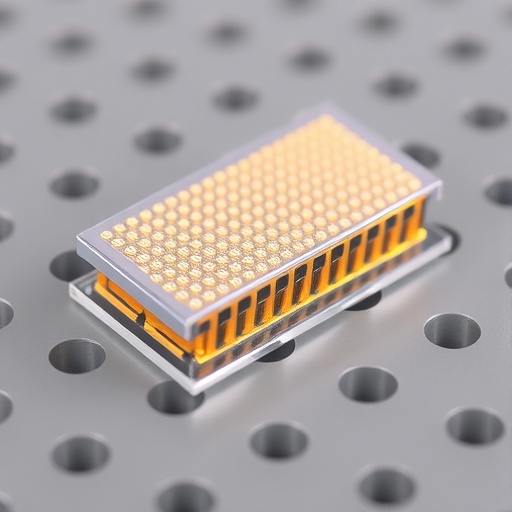In recent years, the demand for efficient energy storage solutions has surged, fueled by the relentless rise of portable electronics and electric vehicles. Central to this burgeoning field is the lithium metal battery, known for its high energy density and performance advantages over conventional lithium-ion batteries. However, challenges remain, particularly concerning the safety, efficiency, and durability of these batteries. Researchers Li, He, Wang, and their colleagues have embarked on a promising exploration into overcoming these obstacles by enhancing the performance of polyolefin separators through innovative modifications.
In their latest study, detailed in the journal Ionics, the researchers focused on creating a separator that is both efficient and safe for lithium metal batteries. The conventional separators used in these batteries often fail to meet the rigorous demands of high-performance applications. These separators need to not only act as physical barriers but also ensure ionic conductivity while preventing lithium dendrite growth, a phenomenon that can lead to short circuits and catastrophic failures.
The innovative approach taken by Li and his team involved modifying commercial polyolefin separators with a copper layer that simulates the effect of a solid electrolyte interface (SEI). Polyvinylidene fluoride (PVDF) was initially used as a polymer matrix, but its limitations prompted the addition of polyethylene imine (PEI). This modification not only enhances the mechanical properties of the separator but also significantly augments its electrochemical performance. The result is a separator that can effectively manage lithium ion transport while mitigating the risks associated with dendrite formation.
The addition of SiO2 to the separator matrix provided further enhancements. Silica is known for its high thermal stability and excellent electrochemical properties. By integrating SiO2 with the PEI-modified polyolefin, the researchers aimed to create a composite separator that maximizes ionic conductivity while simultaneously offering a robust electrochemical interface. The synergy of PEI and SiO2 within the separator matrix represents a noteworthy advancement, as it results in improved battery cycling performance and longevity.
Through rigorous testing, Li and colleagues were able to demonstrate that their modified separators exhibited superior electrochemical stability compared to traditional separators. The batteries incorporating the new separator maintained excellent capacity retention over extended cycling. This capability is crucial, as one significant challenge in the realm of lithium metal batteries is maintaining performance over prolonged use.
The researchers also highlighted the impact of separator thickness on battery performance. Interestingly, thinner separators, combined with the novel modifications, not only facilitated better lithium-ion transport but also improved the overall energy density of the battery system. This observation paves the way for future studies focused on optimizing separator design to achieve maximum performance with minimal material usage, effectively addressing both performance and sustainability concerns.
Of particular note is the thermal stability of the modified separators. The risk of thermal runaway is a critical issue with lithium metal batteries, where excess heat can lead to battery failure or fires. The inclusion of SiO2 in the separator matrix notably raised the thermal stability threshold, providing an essential safety feature that could mitigate the risk of thermal incidents in real-world applications.
The implications of such advancements in separator technology extend beyond merely improving battery performance. The ability to enhance lithium metal batteries by optimizing the separator not only makes electric vehicles more competitive but also pushes the boundaries for large-scale renewable energy storage solutions. As global energy paradigms shift towards sustainable alternatives, innovations like these could play a pivotal role in enabling cleaner energy systems.
As the research landscape continues to evolve, collaborations between material scientists, chemists, and engineers will be essential to fully realize the potential of lithium metal battery technology. The findings of Li, He, Wang, and their collaborators serve as a robust foundation for future investigations, which may lead to even more groundbreaking improvements in battery design and performance.
In conclusion, the work presented by Li and his team represents a significant leap forward in lithium metal battery technology. Their PEI-modified SiO2-enhanced polyolefin separators underscore the innovation necessary to tackle existing challenges in the field. As we move forward, the integration of advanced materials in battery technology will be crucial in shaping the future of energy storage, paving the way for more efficient, sustainable, and safer applications in various sectors.
Such groundbreaking work reinforces the idea that advancements in battery technology are not just a matter of optimizing existing components, but rather a comprehensive approach that includes novel materials and unique configurations to meet the demands of tomorrow’s energy storage challenges. In closing, the potential applications of these improved separators could revolutionize how we think about energy storage, from consumer electronics to green energy solutions, making this area of research one to watch as it continues to unfold.
Subject of Research: Separator modification for lithium metal batteries
Article Title: PEI-modified SiO2-modified commercial polyolefin separator and its performance for lithium metal batteries.
Article References:
Li, J., He, C., Wang, J. et al. PEI-modified SiO2-modified commercial polyolefin separator and its performance for lithium metal batteries. Ionics (2025). https://doi.org/10.1007/s11581-025-06630-5
Image Credits: AI Generated
DOI: https://doi.org/10.1007/s11581-025-06630-5
Keywords: Lithium metal batteries, Polyolefin separators, PEI modification, SiO2 enhancement, Electrochemical performance, Battery safety.




